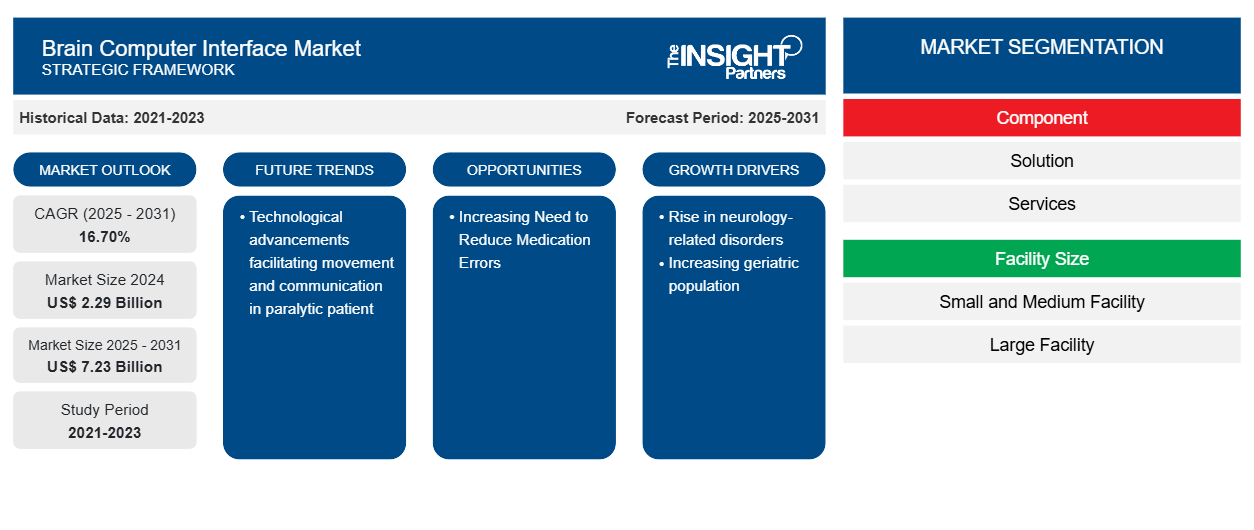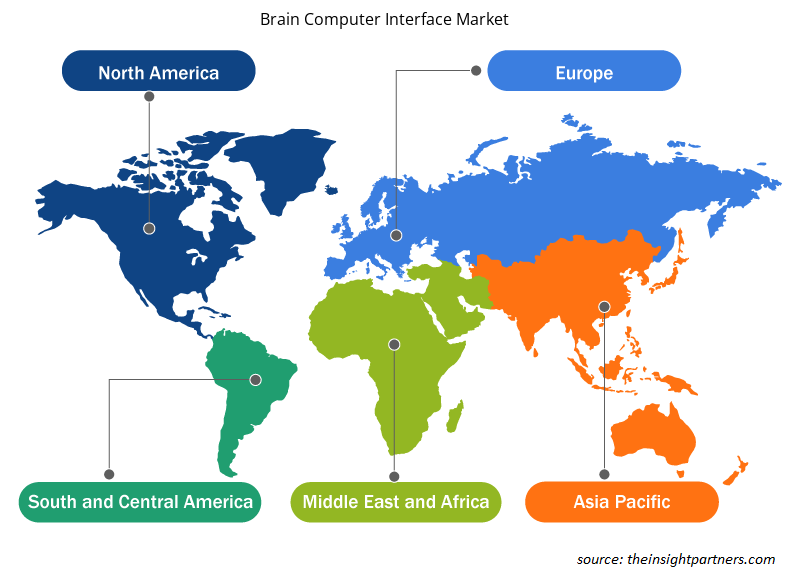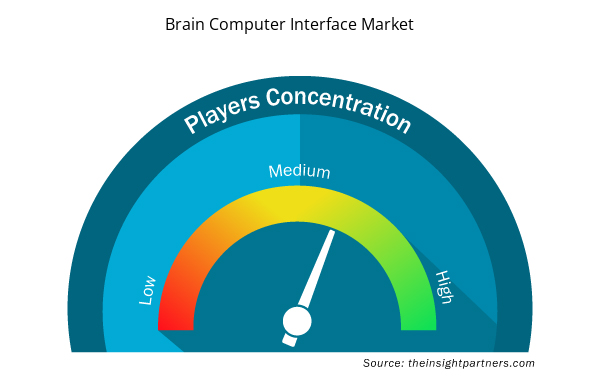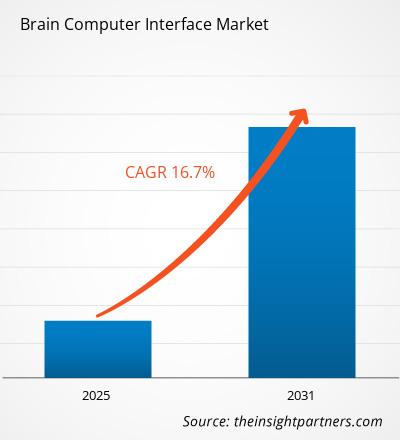The Brain Computer Interface market is projected to grow from US$ 1.96 billion in 2023 to US$ 7.23 billion by 2031; it is expected to expand at a CAGR of 16.70% from 2025 to 2031. Technological advancements facilitating movement and communication in paralytic patients is expected to be key trends in the market.
Brain Computer Interface Market Analysis
Brain computer interface can be viewed as a technological breakthrough that offers the possibility of controlling machines or computers with nothing more than a thought. It represents a fast-growing field of research with practical application of such systems. While some of the earliest brain computer interface technologies imply recorded signals from the brain, the more modern brain computer interface technologies are designed as implants. Such implants improve the skills associated with certain brain activities, such as vision, hearing, or other human or animal functions. Contemporary brain computer interface technologies allow both the decoding of neural activities and the delivery of external signals into targeted brain areas to induce remodeling of neuro synaptic organization, or plasticity.
Plasticity is an innate attribute of the brain and peripheral nervous system (PNS) supporting brain computer interface-based rehabilitation and other neuroscientific applications. While most of the brain computer interface systems translate brain signals to computer commands, some systems utilize external stimulation modes such as transcranial direct current (DC) stimulation and transcranial magnetic stimulation to stimulate specific brain areas. Newer studies indicate that inter-subject operable sensorimotor rhythm-based brain computer interfaces might become viable for subjects who share common brain dynamics. Inter-subject brain computer interface holds promise predominantly for healthy people and in applications such as lie detection, gaming, and drowsiness because rehabilitative brain computer interfaces are required to consider the characteristics and severity of individual impairment.
Brain Computer Interface Market Industry Overview
Brain computer interfaces present a direct communication link between a computer or other external devices and the brain. They provide an extended degree of freedom either by substituting or by strengthening human peripheral functional capacity. Brain-computer interfaces have potential applications across varied verticals, including affective computing, gaming, rehabilitation, robotics, and neuroscience. Brain computer interface systems are a rapid technology involving different hardware and software communication systems for allowing the control of external devices through brain activity. One of the important applications of brain computer interface technology is to assist disabled people. Though most applications of brain-computer interface-related technologies are in healthcare applications, non-healthcare applications such as virtual reality (VR) gaming and device control have also been commercially developed.
Customize This Report To Suit Your Requirement
You will get customization on any report - free of charge - including parts of this report, or country-level analysis, Excel Data pack, as well as avail great offers and discounts for start-ups & universities
Brain Computer Interface Market: Strategic Insights

- Get Top Key Market Trends of this report.This FREE sample will include data analysis, ranging from market trends to estimates and forecasts.
Customize This Report To Suit Your Requirement
You will get customization on any report - free of charge - including parts of this report, or country-level analysis, Excel Data pack, as well as avail great offers and discounts for start-ups & universities
Brain Computer Interface Market: Strategic Insights

- Get Top Key Market Trends of this report.This FREE sample will include data analysis, ranging from market trends to estimates and forecasts.
Brain Computer Interface Market Driver and Opportunities
Rise in Neurology-Related Disorders to Favor Market Growth
Neurological disorders are varied diseases that affect the body’s autonomic nervous system (ANS), peripheral nervous system (PNS), and central nervous system (CNS). The list of non-communicable neurological disorders comprises Alzheimer’s disease, dementia, epilepsy, multiple sclerosis (MS), migraines, non-migraine headaches, and Parkinson’s disease. The number of patients who have disability caused by neurological disorders is increasing at a fast pace globally and is being recognized as a global public health challenge. Health authorities anticipate its burden to rise during the next few decades as a result of the population aging across different nations. MS is often a disabling disease of the CNS and causes the immune system to attack the myelin sheath cover of nerve fibers. It leads to inflammation and lesions, leads to difficulty of the brain in sending signals, and can cause deterioration of the nerves or permanent damage.
Similarly, Parkinson’s disease is a progressive neurological disorder that commonly causes tremors and stiffness or slowing of movement. Symptoms may start gradually, sometimes starting with a barely noticeable tremor in just one hand. Brain-computer interfaces with functional electrical stimulation (FES) as a feedback device are being researched to promote neuroplasticity and improve motor function amongst MS patients. Similarly, brain computer interface technology is being used for adaptive deep brain stimulation in Parkinson’s disease. Such novel applications are driving the brain computer interface market globally.
Increasing Need to Reduce Medication Errors
Brain-computer interfaces (BCIs), a fast-growing technology, have the potential to change how humans interact with computers. Clinical examination of consciousness is based on behavioral tests, which have various limitations. As a result, many people with disorders of consciousness (DOC) are misdiagnosed. Brain-Computer Interface active paradigms may help to assess the level of consciousness, improving the diagnostic precision of the clinical bedside approach. Brain-computer interface (BCI) is a novel approach to integrate technology into healthcare. BCI technology enables direct communication and control between the brain and an external device, thereby replacing traditional neuromuscular channels. The major purpose of BCI in healthcare is to repair or restore functional function to persons with disabilities caused by neuromuscular illnesses.
Brain Computer Interface Market Report Segmentation Analysis
The key segments that contributed to the derivation of the Brain Computer Interface market analysis are coverage component, facility size, and vertical.
- The brain computer interface market is segmented on the basis of component, type, and application. Based on components, the brain computer interface market is bifurcated into hardware and software & service. Hardware was the leading segment in 2022, but the software & service segment is anticipated to grow at a faster rate during the forecast period. By type, the brain computer interface market is divided into invasive and non-invasive. The non-invasive segment held a larger market share in 2022 and is also anticipated to record a faster growth rate during the forecast period. Based on application, the brain computer interface market is segregated into communication & control, entertainment & gaming, healthcare, and others. The healthcare segment acquired the largest share in 2022 and is expected to retain its leading share throughout the forecast period. However, the entertainment & gaming segment is anticipated to record a faster growth rate during the forecast period.
- Hardware acquired the largest market share in 2022 and is expected to continue its domination throughout the forecast period. However, the software & service segment is anticipated to witness a faster growth rate, buoyed by the growing demand for non-intrusive methods and the requirement for capturing critical sensory data. Advanced software solutions are being deployed to omit the practical challenges of the sensitivity of hardware.
Brain Computer Interface Market Share Analysis By Geography
Based on region, the market is segmented into North America, Europe, Asia Pacific, Middle East & Africa, and South & Central America.
North America holds a substantial share of the brain computer interface market. The region has a high penetration of advanced technologies and a higher acceptance of brain computer interfaces. Additionally, the region is a pioneer in research and development of such advanced technologies. Additionally, the US and Canada have been witnessing a significant rise in the number of patients with spinal cord injury or stroke-related disability. Brain-computer interfaces are increasingly being sought for motor rehabilitation in patients who have suffered a stroke or spinal cord injury, leading to upper or lower-limb paralysis. The main aim is to permit patients to train with the aid of a brain-computer interface for a certain time to aid in restitution or improvements in their motor function. These improvements are further assisted by establishing links between the areas of the brain responsible for performing peripheral feedback and movement, thus promoting the reorganization of cortical and cortico-spinal circuits. Most utilized protocols for training include requesting patients to mentally simulate the movement or try to move their paralyzed limb and supporting that action with a robotic exoskeleton or electrical stimulation of the muscles. Such applications are a strong driver of the market in the region.
Brain Computer Interface Market Regional Insights
The regional trends and factors influencing the Brain Computer Interface Market throughout the forecast period have been thoroughly explained by the analysts at Insight Partners. This section also discusses Brain Computer Interface Market segments and geography across North America, Europe, Asia Pacific, Middle East and Africa, and South and Central America.

- Get the Regional Specific Data for Brain Computer Interface Market
Brain Computer Interface Market Report Scope
| Report Attribute | Details |
|---|---|
| Market size in 2024 | US$ 2.29 Billion |
| Market Size by 2031 | US$ 7.23 Billion |
| Global CAGR (2025 - 2031) | 16.70% |
| Historical Data | 2021-2023 |
| Forecast period | 2025-2031 |
| Segments Covered |
By Component
|
| Regions and Countries Covered | North America
|
| Market leaders and key company profiles |
Brain Computer Interface Market Players Density: Understanding Its Impact on Business Dynamics
The Brain Computer Interface Market market is growing rapidly, driven by increasing end-user demand due to factors such as evolving consumer preferences, technological advancements, and greater awareness of the product's benefits. As demand rises, businesses are expanding their offerings, innovating to meet consumer needs, and capitalizing on emerging trends, which further fuels market growth.
Market players density refers to the distribution of firms or companies operating within a particular market or industry. It indicates how many competitors (market players) are present in a given market space relative to its size or total market value.
Major Companies operating in the Brain Computer Interface Market are:
- Integra LifeSciences Corporation
- Mindmaze
- CASMED
- EMOTIV
- Compumedics Limited
- Advanced Brain Monitoring, Inc.
Disclaimer: The companies listed above are not ranked in any particular order.

- Get the Brain Computer Interface Market top key players overview
Brain Computer Interface Market News and Recent Developments
The Brain Computer Interface market is evaluated by gathering qualitative and quantitative data post primary and secondary research, which includes important corporate publications, association data, and databases. A few of the developments in the Brain Computer Interface Market are listed below:
- Neuralink announced that it has received approval from an independent review board (IRB) to recruit consensual participants for the first human trial of its brain implant designed for patients with paralysis. Individuals with paralysis resulting from cervical spinal cord injuries or amyotrophic lateral sclerosis (ALS) may qualify for participation in this study. During the study, a brain computer interface device is expected to be surgically implanted by a robot in the target region of the brain. The Elon Musk-owned company’s initial objective is to enable patients to control a computer keyboard or cursor solely through their thoughts. (Source: Neuralink, Press Release, September 2023)
Brain Computer Interface Market Report Coverage & Deliverables
The Brain Computer Interface market forecast is estimated based on various secondary and primary research findings, such as key company publications, association data, and databases. The market report "Brain Computer Interface Market Size and Forecast (2021–2031)" provides a detailed analysis of the market covering below areas-
- Brain Computer Interface Market size and forecast at global, regional, and country levels for all the key market segments covered under the scope
- Brain Computer Interface Market trends, as well as market dynamics such as drivers, restraints, and key opportunities
- Detailed PEST/Porter’s Five Forces and SWOT analysis
- Brain Computer Interface Market analysis covering key market trends, global and regional framework, major players, regulations, and recent market developments
- Industry landscape and competition analysis covering market concentration, heat map analysis, prominent players, and recent developments in the Brain Computer Interface Market
- Detailed company profiles.
- Historical Analysis (2 Years), Base Year, Forecast (7 Years) with CAGR
- PEST and SWOT Analysis
- Market Size Value / Volume - Global, Regional, Country
- Industry and Competitive Landscape
- Excel Dataset



Report Coverage
Revenue forecast, Company Analysis, Industry landscape, Growth factors, and Trends

Segment Covered
This text is related
to segments covered.

Regional Scope
North America, Europe, Asia Pacific, Middle East & Africa, South & Central America

Country Scope
This text is related
to country scope.
Frequently Asked Questions
Technological advancements facilitating movement and communication in paralytic patients are the major trend in the market.
Integra LifeSciences Corporation, Mindmaze, CASMED, EMOTIV, Compumedics Limited, Advanced Brain Monitoring, Inc., Natus Medical Incorporated., OpenBCI, Cadwell Industries, Inc., Neurable, Kernel, CorTec GmBH, Nexstem, BitBrain, ANT Neuro, Ripple Neuro, Paradromix, Cognixion, and AAVAA Inc. are the major market players.
Some of the customization options available based on the request are additional 3–5 company profiles and a country-specific analysis of 3–5 countries of your choice. Customizations are to be requested/discussed before making final order confirmation, as our team would review the same and check the feasibility.s
The rise in neurology-related disorders and the increasing geriatric population are the major factors that drive the global Brain Computer Interface market.
The global Brain Computer Interface market was estimated to grow at a CAGR of 17.8% during 2023 - 2031.
The report can be delivered in PDF/PPT format; we can also share an Excel dataset based on the request.

 Get Free Sample For
Get Free Sample For